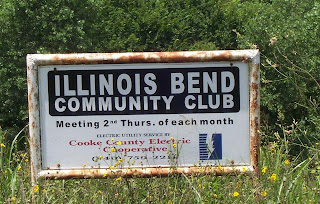Today I went to Illinois Bend, expecting to see nothing, but
saw the opposite. If you’re wondering why I’d go anywhere to see nothing, I
should probably explain.
It is commonly supposed that the “disposable” society is a
relatively modern phenomenon. Not so. The US is littered with “ghost towns”:
towns that once thrived, but are now little more than an uninhabited shell, or
even ruins. There are many reasons for a community to die out – the most
obvious are:
- If the community was founded on a natural resource, such as gold or coal, then when the resource dries up, so does the community.
- If the community relies on the railroad for its revenue, and the railroad is re-routed, or no longer has a need to stop there, it dies.
- If the community relies on through-traffic for its income, and is subsequently bypassed by “super-highways”, the residents are forced to relocate.
There are other reasons, of course, and many
counter-examples – some sufficiently enterprising communities “reinvented” themselves,
instead of giving up. I’m sure there are earlier examples of the “disposable”
society – all it takes is enough space for man’s natural lethargy to triumph
over good sense, and you finish up with the desertification of Africa, the
ghost-towns of America, Australia and Canada, and, more recently,
crumbling ex-Walmart buildings.
I found on the internet (http://www.ghosttowns.com/states/tx/tx.html)
a list of Texas ghost-towns, and fully intend,
one day, to visit some of the remoter ones in West Texas.
For today, however, I found Illinois Bend, in North Texas – east of the
panhandle and just below the Oklahoma
border. “Illinois
Bend was named by homesick settlers from Illinois - who moved to Texas in 1862. Before their arrival it had
been named Wardville after a local landowner, C. M. Ward. The name was changed
to Illinois Bend in 1877 when a post office was granted
for the community. Illinois Bend had a population of 300 by the
mid-1880s.”
To get there, as you’d imagine, you travel into rural North Texas, where I was surprised to see the kind of panoramic view that is more common in the Hill Country than in the northern Plains. It is particularly pretty because, after the wettest June since 1928, the flora is still lush, instead of the more typical scorched appearance of the Texas July.
 |
| Illinois Bend Church |
 |
| The Community Club |
The high fences on either side of the road were an obvious
sign that I was in deer-ranching country, and Illinois Bend was well signposted
– a little odd, I thought, for a ghost town to be signposted just like any of
the neighboring towns. In spite of the internet reference to its location (20 miles northwest of Montague) being
wrong (it’s northeast), I’d already determined the route, and soon found myself in a town which, while
possibly not actually thriving, was certainly not a ghost town! Perhaps
somebody should tell the residents to stop building their new Community Center,
and terminate the weekly meetings there, although it’s certainly true that the
church could use a little work (I think just writing “Revival” on a sign outside the church won’t cut it).
I started to wonder if there could be two Illinois Bends, or if they could have relocated? The answer was
to be found at the local cemetery. Such a peaceful place – the sultry air
punctuated only by bird-calls, cicadas chirping and the buzzing of flies. It
looks to me as though people have been dying round here for quite a while (the
earliest recorded death I could read on a headstone was in 1898), so I think
that this is the one and only Illinois Bend. Either my internet reference is
wrong (surely not? Ed.), or the town
has been resurrected. In any case, I wish them luck – it was like discovering
an ancient relative, whom you had assumed had long since passed on, to be alive
and well.
Here’s an image that
you’ll only see twice a year around here: fireworks on sale. By law, fireworks
in Texas can
only be sold from June 24th – July 4th, and December 20th
– January 1st.
Happy July 4th!

